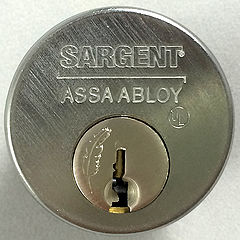Sargent Signature
Sargent Signature
| Sargent Signature | |
 | |
| Name | Sargent Signature |
|---|---|
| Manufacturer | Sargent |
| Lock Type | Cylinder |
| Lock Design | Pin-tumbler, Sidebar |
| Year(s) Produced | 2007-Present |
The Sargent Signature is a pin-tumbler lock made by Sargent. It uses side pins and two sidebars in addition to its regular six pin-tumblers. It is sold as a "security" tier lock, intended to provide increased key control and resistance against picking. It can be integrated into existing Sargent systems as Signature keys are backwards compatible with ordinary Sargent locks.
It is easily identified by the quill on the left side of the plug face.
Principles of Operation
The Sargent Signature uses six pin-tumblers and six side pins that interface with two sidebars located at 5 and 7 'o clock. All six pin-tumblers and six side pins must be set to the correct depth for the lock to open. The side pins are installed with three on the left side of the plug and three on the right. They move perpendicular to the top pins, matching with dimple cuts on the sides of the key. Grooves are cut at varying depths along the side pins. When the side pin is set to the correct depth, the sidebars can be depressed into them, allowing the plug to turn.
The pin-tumbler portion of the lock uses identical pinning specifications to standard Sargent cylinders. There are 10 possible cuts with a MACS of 5, giving 1,000,000 (106) theoretical key differs for the pin-tumbler portion of the lock. Master keying is available for the pin-tumbler portion. [1] Top (driver) pins are all standard, however, stainless steel spooled pins are available for UL437 versions.
The side pins are installed in the factory in three of five possible positions between the pin chambers, at 4 and 8 o' clock on the plug. They are not removeable nondestructively. In addition, there are two side pins installed at the very front of the plug intended to block non-signature keys from being inserted. These "blocking pins" are identical to the other side pins, except they do not interact with the sidebar.[2] Signature keys have two small slopes cut on either side of the very tip of the key in a wedge shape to depress these pins as the key is inserted. There are no false gates cut on the side pins; however, the tips are narrowed to prevent them from entering too far into the keyway, and this may act as such if the pins are depressed too far.
Steel inserts are used to increase resistance to forced entry. Two roll pins are installed in front of the pinstacks in the plug, and a crescent shaped disc is set into the 12 o' clock position on the housing to protect the upper pin chambers. The sidebars are made out of steel. In addition, some bottom pins may be made of steel.
Notes
- Dimple cuts on the key are done at the factory, similar to other sidebar designs such as the ASSA Twin 6000 or the Schlage Primus.
Disassembly instructions
The Sargent Signature can be disassembled in the same way as a standard pin-tumbler lock. The two sidebars will fall out when the plug is removed from the housing.
- Remove the cam or C-clip.
- Insert the key and turn the plug 45-90 degrees.
- Withdraw the plug from the cylinder. (A plug follower is recommended)
OR
- Remove the chamber casings and take out each pin-stack individually
- Remove the cam or C-clip.
- Withdraw the plug from the cylinder.
Notes
- Two small dimples drilled on the back end of the housing in a figure-8 shape indicate that the pin chambers may be top-loaded by removing the retaining cover.
Vulnerabilities
The Sargent Signature may be vulnerable to one of more of the following:
Notes
- Key bumping is only possible given a bump key with the correct sidebar bitting.









